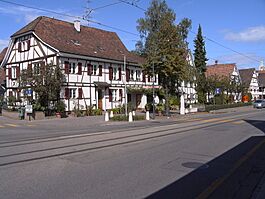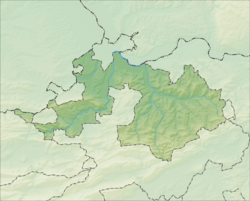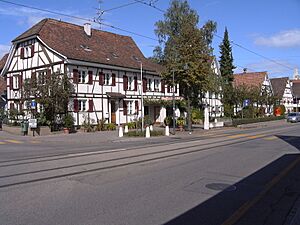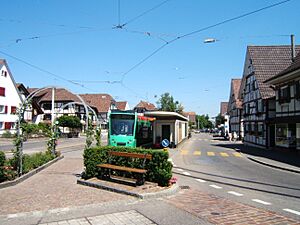Allschwil facts for kids
Quick facts for kids
Allschwil
|
||
|---|---|---|

Allschwil village
|
||
|
||
| Country | Switzerland | |
| Canton | Basel-Landschaft | |
| District | Arlesheim | |
| Area | ||
| • Total | 8.9 km2 (3.4 sq mi) | |
| Elevation
(Dorfplatz)
|
285 m (935 ft) | |
| Population
(Jun 2021 )
|
||
| • Total | 21,563 | |
| • Density | 2,423/km2 (6,280/sq mi) | |
| Demonym(s) | German: Allschwiler(in) | |
| Postal code |
4123
|
|
| Localities | Neuallschwil | |
| Surrounded by | Baselland (BL), Binningen, Buschwiller (FR-68), Hégenheim (FR-68), Neuwiller (FR-68), Oberwil, Saint-Louis (FR-68), Schönenbuch | |
| Twin towns | Pfullendorf (Germany), Blaj (Romania) | |
Allschwil is a village and a municipality in the Arlesheim district. It is located in the canton of Basel-Country in Switzerland.
Allschwil is a suburb right next to Basel city. It sits between Basel to the east and Alsace in France to the west.
The official language in Allschwil is German. However, most people speak a local Alemannic dialect called Swiss German.
Contents
Allschwil's Story: A Look Back in Time
Allschwil was first mentioned in old writings in 1118. Back then, it was called Almswilre.
Ancient Times in Allschwil
People have lived in the Allschwil area for a very long time. Archeologists have found tools from the Middle Paleolithic period. This was a very early time in human history.
They also found ancient cups from the Glockenbecherkultur (around 2400–1800 BC). A hidden collection of metal items from the Bronze Age was also discovered. There was even a settlement from the Hallstatt culture at a place called in den Vogelgärten.
In 1937, a Gallo-Roman cemetery was found. This cemetery was for cremations and dates back to about AD 25–60. It is one of the oldest in northern Switzerland. Some people think Allschwil might be the Roman road station Arialbinum.
Allschwil in the Middle Ages
Allschwil was part of an area called the Herrschaft of Birseck. This land was given to the Bishop of Basel in 1004. Over time, this land was often traded or sold.
Allschwil was located on an important trade route. This route connected Alsace and Solothurn through the Passwang pass. Because it was on a border and a trade route, Allschwil became an important place for customs. Customs are like taxes paid on goods crossing a border.
After 1724, Allschwil had a salt warehouse. This was for the Bishop of Basel's area. Allschwil was also one of seven "free villages." This meant it had special ties to Basel's cathedral for church services.
In 1525, Allschwil joined Basel with a special agreement. This happened during the German Peasants' War. The agreement was later ended in 1585.
In 1529, the village adopted the Protestant Reformation. This was a big change in religious beliefs. But in 1627, the Bishop of Basel brought the Counter-Reformation to Allschwil. This meant the village returned to being Catholic.
After 1567, Jewish people lived in Allschwil. By 1692, about 24 Jewish families lived in a special alley. They had their own cemetery nearby. Children of Jewish and Christian families went to school together. In 1694, a decree from the Bishop caused many Jewish families to move to Hegenheim.
The village Church of St. Peter and Paul was built in the 12th century. The bottom part of its tower is from the 12th or 13th century. The rest of the church was rebuilt in 1698–99.
Allschwil in Recent Centuries
From 1793 to 1814, Allschwil was under French rule. This was after the short-lived Rauracian Republic. Unlike other villages, Allschwil did not like French rule. There was even a small rebellion in 1794.
In 1815, Allschwil became part of the Canton of Basel. Later, in 1833, the canton split into Basel-City and Basel-Country. Allschwil became part of Basel-Country. This split also changed religious power in Allschwil.
In 1877, the village church became Christian Catholic. In 1878, the Swiss Reformed Church started a church in Allschwil. By 1970, about 54% of people were Swiss Reformed. About 40% were Roman Catholic.
Modern Allschwil
By 1860, Allschwil changed from a farming village to an industrial town. Many people worked in factories in Basel. Farmers mostly grew grain and vegetables for Basel's market. Allschwil was famous for its white cabbage.
From 1897 to 1921, a sauerkraut factory processed the cabbage. By the late 1800s, crops like hemp and flax were no longer grown. Vineyards also disappeared.
In 1955, there were 63 farms. By 1965, this number dropped to 29. The industrial sector grew a lot until 1930. Many people worked in brick, clothing, metal, and machinery factories.
Several brick factories opened in the 1870s. One company, Passavant-Iselin & Co., had Switzerland's first interlocking tile press. This company closed in 1975.
Allschwil did not get a railway connection. This stopped it from growing even more industrially. Also, with more shipping on the Rhine River, Allschwil became less important for customs.
A tram line to Basel opened in 1905. By 1910, about 40% of workers traveled out of Allschwil for their jobs. By 1990, this number grew to 79%.
Today, Allschwil focuses on light industry. This includes industrial metals, paper, and chemistry. In 1990, 35% of workers were in industry. 54% worked in service jobs.
Allschwil's population grew a lot between 1850 and 1970. This was due to people moving from Basel. In 1930, it was the most populated municipality outside Basel. This led to some problems with its infrastructure.
Since 1970, population growth has slowed down. The center of the town still looks like a village. Old half timbered houses from the mid-1800s have been restored. These efforts won awards in 1976 and 1980. A town history museum opened in 1968. The Allschwiler market started in 1977.
Where is Allschwil?
Allschwil covers an area of about 8.92 square kilometers (3.44 square miles). About 29.4% of this land is used for farming. Forests cover about 27.0% of the area.
Buildings and roads take up about 43.0% of the land. A small part, 0.2%, is rivers or lakes. About 0.3% of the land is not used for anything.
The municipality is in the Arlesheim district. It is on the edge of the Sundgauer Hill Country. This area is along the Upper Rhine valley.
Allschwil is a suburb of Basel to the west. It shares a border with France on two sides. Its Swiss neighbors are Schönenbuch, Oberwil, and Binningen. The French towns nearby are Neuwiller, Buschwiller, Hégenheim, and Saint-Louis.
The landscape is typical of the Rhine valley. The Rhine River flows through hills, forming a border with Germany. Then it flows north through a wide plain, bordering France and Germany.
Allschwil's Coat of Arms
The blazon (description) of Allschwil's coat of arms is simple. It shows a silver sword and a golden key crossed over each other on a blue background.
People of Allschwil
Allschwil has a population of about 19,221 people (as of 2022). About 20.0% of the people living here are foreign nationals. Over the last 10 years, the population has changed very little.
Most people (about 86.5%) speak German. Italian language is the second most common language (3.2%). French is third (2.4%).
In 2008, about 47.8% of the population was male and 52.2% was female. Most residents (78.8%) were Swiss citizens. About 21.2% were not Swiss.
Many people (22.5%) were born in Allschwil. Others were born elsewhere in Switzerland (43.7%) or outside Switzerland (21.8%).
In 2008, there were more births than deaths for non-Swiss citizens. For Swiss citizens, there were more deaths than births. Overall, the population grew by 1.9% in 2008.
In 2010, about 6.3% of the population were children aged 0-6. Teenagers (7-19) made up 11.1%. Adults aged 20-64 made up a large part of the population (60.9%). Older adults (65 and over) made up 21.8%.
In 2000, there were about 8,751 households in Allschwil. The average household had 2 people. About 38.7% of households had only one person.
The historical population of Allschwil is shown in this chart:

Important Sites
The entire village of Allschwil is recognized as an important Swiss heritage site. This means it has special historical and cultural value.
Allschwil's Economy
Allschwil is home to many companies. These companies work in chemistry, pharmaceuticals (medicines), and biotechnology. Some well-known names include Actelion, Abbott, Spexis, MDL Information Systems, and Idorsia Pharmaceuticals.
In 2007, Allschwil had a low unemployment rate of 2.36%. In 2005, about 112 people worked in the primary economic sector (like farming). About 2,647 people worked in the secondary sector (like manufacturing). The largest group, 5,190 people, worked in the tertiary sector (like services).
In 2008, there were 7,613 full-time jobs in Allschwil. Most of these jobs were in manufacturing (70.2%) and construction (27.3%) within the secondary sector. In the tertiary sector, many jobs were in sales, science, and healthcare.
Allschwil is now mostly a residential community for people who work in Basel. It also has some light industry, especially in electronics, chemicals, and biotech. It's a popular place to live because it's close to the city but still feels like the countryside. Another reason people like living here is because of its lower taxes.
Religion in Allschwil
Based on the 2000 census, about 35.2% of the people in Allschwil were Roman Catholic. About 32.8% belonged to the Swiss Reformed Church.
Smaller groups included members of Orthodox churches (1.05%) and the Christian Catholic Church (1.38%). Other Christian churches made up 2.29%.
There were also people who were Jewish (0.31%) and Islamic (2.56%). Some residents were Buddhist (56 people) or Hindu (114 people). About 19.63% of the population did not belong to any church.
Learning in Allschwil
In Allschwil, about 43.6% of the population has finished upper secondary education. This is education after middle school that is not mandatory. About 15.7% have gone on to higher education, like university.
In 2000, 116 students came to Allschwil for school from other towns. At the same time, 650 residents of Allschwil went to schools outside the municipality.
Getting Around: Public Transport
Allschwil has good public transport connections. It is served by several tram and bus lines.
- Tram 6: Connects Allschwil to Basel and Riehen.
- Tram 8: Ends near the Allschwil border in Basel, making it easy to reach.
- Bus 31: Travels from Allschwil to Schifflände and Habermatten.
- Bus 33: Connects Schönenbuch, Allschwil, and Schifflände.
- Bus 38: Goes from Allschwil to Schifflände and even to Grenzach Wyhlen in Germany.
- Bus 48: Connects Bachgraben, Ziegelei, Wanderstrasse, and the SBB railway station.
- Bus 61: Travels between Letten, Binningen, and Oberwil.
- Bus 64: Connects Bachgraben, Ziegelei, Oberwil, Therwil, Reinach, and Arlesheim Dorf.
There are also plans to build a new railway station. This station would be on the SNCF line from Basel to Mulhouse. Even though it would be in Basel, it would be very close to Allschwil. This would make it easy for Allschwil residents to use.
Famous People from Allschwil
- Alfred Jäck (1911–1953): A footballer who played 28 games for the Swiss national team.
- Ricco (1915–1972): Born Erich Wassmer, he was a Swiss painter known for his "magic realism" style.
- Jürg Marmet (1927–2013): A mountaineer who was part of the first two-man Swiss team to climb Mount Everest in 1956.
- Heidi Baader-Nobs (born 1940): A composer who lived in Allschwil.
- Harry Schaffer (born 1963): An artist and interior architect who grew up in Allschwil.
- Giuseppe Morello (born 1985): A Swiss-Italian footballer.
See also
 In Spanish: Allschwil para niños
In Spanish: Allschwil para niños









